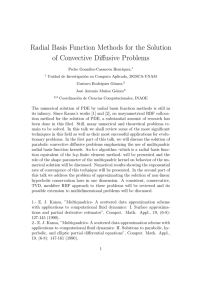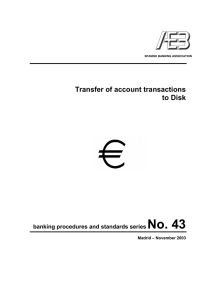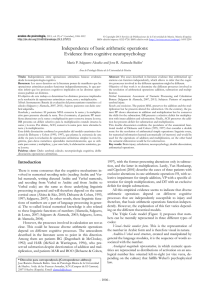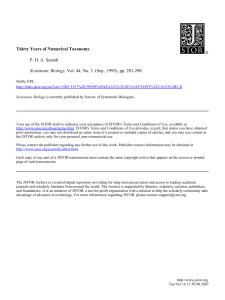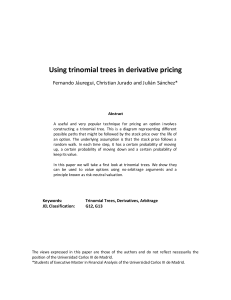numerical comparison of pricing of european call options for mean
Anuncio
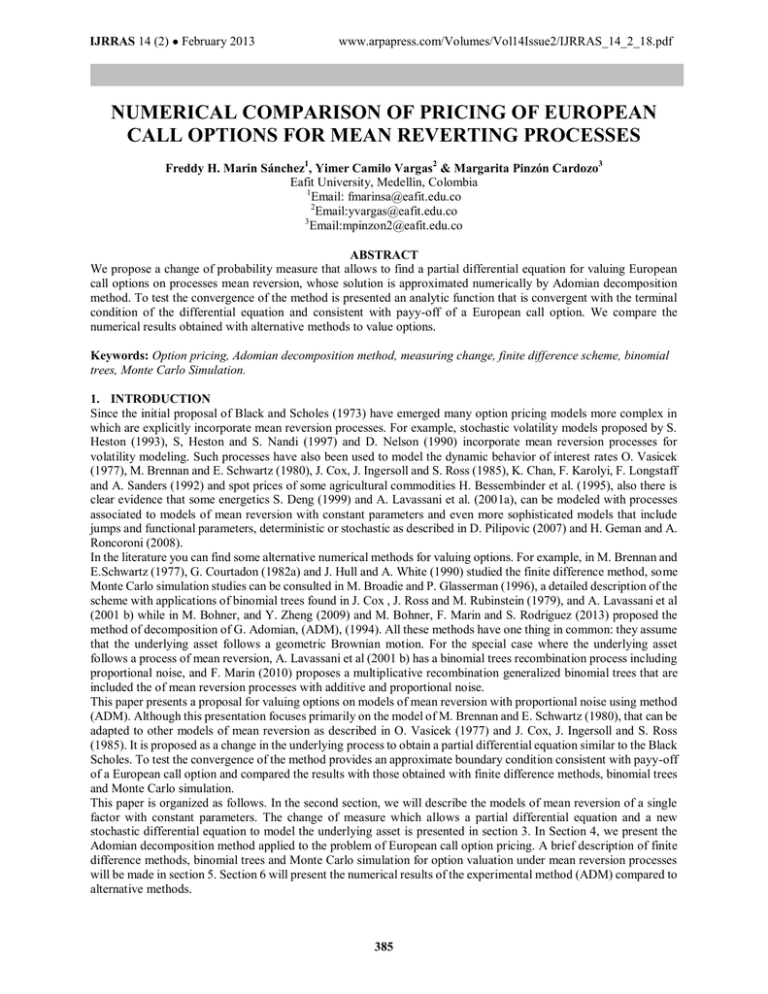
IJRRAS 14 (2) ● February 2013 www.arpapress.com/Volumes/Vol14Issue2/IJRRAS_14_2_18.pdf NUMERICAL COMPARISON OF PRICING OF EUROPEAN CALL OPTIONS FOR MEAN REVERTING PROCESSES Freddy H. Marín Sánchez1, Yimer Camilo Vargas2 & Margarita Pinzón Cardozo3 Eafit University, Medellín, Colombia 1 Email: [email protected] 2 Email:[email protected] 3 Email:[email protected] ABSTRACT We propose a change of probability measure that allows to find a partial differential equation for valuing European call options on processes mean reversion, whose solution is approximated numerically by Adomian decomposition method. To test the convergence of the method is presented an analytic function that is convergent with the terminal condition of the differential equation and consistent with payy-off of a European call option. We compare the numerical results obtained with alternative methods to value options. Keywords: Option pricing, Adomian decomposition method, measuring change, finite difference scheme, binomial trees, Monte Carlo Simulation. 1. INTRODUCTION Since the initial proposal of Black and Scholes (1973) have emerged many option pricing models more complex in which are explicitly incorporate mean reversion processes. For example, stochastic volatility models proposed by S. Heston (1993), S, Heston and S. Nandi (1997) and D. Nelson (1990) incorporate mean reversion processes for volatility modeling. Such processes have also been used to model the dynamic behavior of interest rates O. Vasicek (1977), M. Brennan and E. Schwartz (1980), J. Cox, J. Ingersoll and S. Ross (1985), K. Chan, F. Karolyi, F. Longstaff and A. Sanders (1992) and spot prices of some agricultural commodities H. Bessembinder et al. (1995), also there is clear evidence that some energetics S. Deng (1999) and A. Lavassani et al. (2001a), can be modeled with processes associated to models of mean reversion with constant parameters and even more sophisticated models that include jumps and functional parameters, deterministic or stochastic as described in D. Pilipovic (2007) and H. Geman and A. Roncoroni (2008). In the literature you can find some alternative numerical methods for valuing options. For example, in M. Brennan and E.Schwartz (1977), G. Courtadon (1982a) and J. Hull and A. White (1990) studied the finite difference method, some Monte Carlo simulation studies can be consulted in M. Broadie and P. Glasserman (1996), a detailed description of the scheme with applications of binomial trees found in J. Cox , J. Ross and M. Rubinstein (1979), and A. Lavassani et al (2001 b) while in M. Bohner, and Y. Zheng (2009) and M. Bohner, F. Marin and S. Rodriguez (2013) proposed the method of decomposition of G. Adomian, (ADM), (1994). All these methods have one thing in common: they assume that the underlying asset follows a geometric Brownian motion. For the special case where the underlying asset follows a process of mean reversion, A. Lavassani et al (2001 b) has a binomial trees recombination process including proportional noise, and F. Marin (2010) proposes a multiplicative recombination generalized binomial trees that are included the of mean reversion processes with additive and proportional noise. This paper presents a proposal for valuing options on models of mean reversion with proportional noise using method (ADM). Although this presentation focuses primarily on the model of M. Brennan and E. Schwartz (1980), that can be adapted to other models of mean reversion as described in O. Vasicek (1977) and J. Cox, J. Ingersoll and S. Ross (1985). It is proposed as a change in the underlying process to obtain a partial differential equation similar to the Black Scholes. To test the convergence of the method provides an approximate boundary condition consistent with payy-off of a European call option and compared the results with those obtained with finite difference methods, binomial trees and Monte Carlo simulation. This paper is organized as follows. In the second section, we will describe the models of mean reversion of a single factor with constant parameters. The change of measure which allows a partial differential equation and a new stochastic differential equation to model the underlying asset is presented in section 3. In Section 4, we present the Adomian decomposition method applied to the problem of European call option pricing. A brief description of finite difference methods, binomial trees and Monte Carlo simulation for option valuation under mean reversion processes will be made in section 5. Section 6 will present the numerical results of the experimental method (ADM) compared to alternative methods. 385 Marín & al. ● Numerical Solution of Pricing of European Call IJRRAS 14 (2) ● February 2013 2. MEAN REVERSION PROCESSES OF A SINGLE FACTOR The unidimensional mean reversion processes with one factor with constant parameters are given by the general equation dxt = ( L xt )dt xt dBt ; t 0; T defined on a complete probability space , , t t 0 , with a filtration t , (1) with initial condition 3 x0 = x , where > 0, > 0, L R and 0, are constants and Bt t 0 is a Unidimensional standard 2 Brownian motion defined on the same space. The parameter is known as reversion rate, is the parameter associated with the volatility, is the elasticity of variance and L is the level of average or trend reversal long run equilibrium, ie a finite time horizon, L plays the role of an attractor in the sense that where xt > L the trend term L xt < 0 and therefore xt decreases and when xt < L a similar argument establishes that xt grows. The Equation (1) is known as CKLS model proposed by K. Chan, F. Karolyi, F. Longstaff and A. Sanders (1992) and is a generalization of the models of interest rate in the short term with constant parameters in which = 0,1 / 2,1 or with = 0 . Although this general model derived various interest rate models studied in the literature, our interest focuses primarily on the special case = 1 . That is, the process has proportional noise and obtained a inhomogeneous linear stochastic differential equation given by = 32 dxt = L xt dt xt dBt , x0 = x; t 0; T (2) which is used by M. Brennan and E. Schwartz (1980) to obtain a numerical model of convertible bond prices. This process is also used by G. Courtadon (1982b) in developing a model of option pricing on discount bonds. 3. CHANGE OF MEASURE As the expected value of the discounted payment of a derivative under the subjective probability would lead to arbitrage opportunities, it is necesary build a unique probability measure equivalent to such that the discounted price at the rate of risk-free interest r , is a martingale and the expected value of the derivative instrument * discounted payment under the objective probability present no arbitrage opportunities. In M. Garman (1976), J, Cox, J. Ingersoll and S. Ross (1985) and J. Hull and A. White (1990) states that the value of the option u x, t where the underlying asset follows a process given by equation (2) must satisfy the partial differential equation * u u 1 2u 2 2 L x x, t x x ru = 0 t x 2 x 2 x, t (3) x , and r is the risk free rate. In S. Heston (1993) assumes that the market risk is proportional to volatility, ie, nonnegative constant such that x,t = . where represents the market risk for Consequently, equation (3) is being u u 1 2u 2 2 L x x x ru = 0 t x 2 x 2 (4) A European call option with strike price K and time to maturity T satisfies the equation (4) and the problem is complete, subject to the following boundary conditions u(0, t ) = 0; u( x, T ) = Maxx K ,0 386 (5) Marín & al. ● Numerical Solution of Pricing of European Call IJRRAS 14 (2) ● February 2013 For Girsanov theorem (see Mao, X. (1997)), dBt* = dBt x, t dt (6) t d * 2 1 t = exp x, u du x, u dBu 0 d 2 0 (7) L x x, t = 1 r (8) Where is the measure in the real world under the subjective probability and Bt * motion. Under the objective probability The modified parameters are 0t T is a * - Brownian * , equations (2) and (4) are being respectively dxt = xt dt xt dBt* (9) u u 1 2u 2 2 x x ru = 0 t x 2 x 2 (10) = and = L ; where, r : Is the interest rate risk free. : Reversion rate. : Volatility of the underlying asset. : Reversion level half or steady trend 4. ADOMIAN DECOMPOSITION METHOD Following the results of G. Adomian (1994) and D. Lesnic (2006), consider the partial differential equations, linear time-dependent one-dimensional form N n ( x, t ) n=0 M nu mu ( x , t ) = ( x , t ) ( x, t ) f ( x, t ), ( x, t ) 2 , m m t n x m =1 where n ,0 n N y m ,1 m M are known coeficients , integers and subject to the conditions nu ( x,0) = g n ( x), t n 0 n N 1, x y n 0, m 0 mu (0, t ) = f m (t ) x m , y (11) N , M are positive 0 m M 1, t (12) Define the following differential operators: n Gn = n , t 0n N m y Fm = m x 387 1 m M (13) Marín & al. ● Numerical Solution of Pricing of European Call IJRRAS 14 (2) ● February 2013 with the convention G0 = F0 = I , is the identity operator. Then the equations (11) and (12)can be rewritten as N M n=0 m =1 n ( x, t )Gn u( x, t ) = m ( x, t ) Fm u( x, t ) f ( x, t ), ( x, t ) 2 Gn ( x,0) = g n ( x), 0 n N 1, x (14) 0 m M 1, t (15) y Fm (0, t ) = f m (t ) where the inverse integral operator is formally defined as t =t t1 t 0 0 GN1 = 0 0 ... N 1dt N ...dt1 , FN1 = x0 = x x1 0 0 ... xM 1 0 dxM ...dx1 (16) Applying (16)to (14) and (15) is obtained M f ( x, t ) N 1 t n ( x, t ) N ( x, t ) g n ( x) GN1 m u ( x, t ) = GN1 Fmu ( x, t ) GN1 n Gnu ( x, t ) . (17) m =1 N ( x, t ) n=0 n! N ( x, t ) n=0 N ( x, t ) Using the ADM (1994), the following relationship is defined for equation (17) and for f ( x, t ) N 1 t l g l ( x), u0 ( x, t ) = GN1 N ( x, t ) l =0 l! (18) M ( x, t ) N ( x, t ) uk 1 ( x, t ) = GN1 m Fm GN1 n Gn uk ( x, t ) ( x , t ) ( x , t ) m = 1 n = 0 N N (19) k 0 in this way the solution can be represented by u ( x, t ) = uk ( x, t ) (20) k =0 4.1 Approximate analytical solution for model of mean reversion For the special case in which N = 1, M = 2, 0 = r , α1 = 1, 0 = 0, φ1 = x, 2 = 2 2 x 2 , we obtain the terminal value problem consisting of the partial differential equation u u 1 2u 2 2 x x ru = 0 t x 2 x 2 (21) u( x, T ) = g ( x) = Maxx K ,0 (22) and the terminal condition Applying the above formulas (18)and (19) the problem (21) and (22) is obtained 388 Marín & al. ● Numerical Solution of Pricing of European Call IJRRAS 14 (2) ● February 2013 u0 ( x, t ) = g ( x) and for (23) k 0 , 2 ( x, t ) 0 1 n ( x, t ) uk 1 ( x, t ) = G11 m Fm G1 Gn uk ( x, t ) m=1 1 ( x, t ) n =0 1 ( x, t ) 2 2 = G11 xF1 x F2 rG0 uk ( x, t ) 2 (24) t u ( x, ) 2 2 2uk ( x, ) = x k x ruk ( x, ) ds 2 T x 2 x ie, 2 T T 2uk ( x, s) u ( x, s) u ( x, s) uk 1 ( x, t ) = x 2 x k ruk ( x, s) ds k ds 2 t t x x x 2 (25) By Theorem (2.1) in M. Bohner and Y. Zheng (2009), the recursively defined functions (23) and (25) can be represented explicitly as 2k 2 k m (1) mv k m ( m) (T t ) k (T t ) k uk ( x, t ) = v x g ( x) g ( m ) ( x) k! m=0 m=0 v =0 v!(m v)! k! (26) in compact form, 2k 2 k m (1) mv k m ( m ) (T t ) k ( m) u k ( x, t ) = v x g ( x) g ( x) , k 0 m=0 m=0 v =0 v!(m v)! k! (27) Thus the solution is given by m v 2k (T t ) k 2 k m (1) k m ( m) ( m) u ( x, t ) = v x g ( x) g ( x) , k 0 k =0 m=0 k! m=0 v =0 v!(m v)! where, m = m( 2 2 (28) (m 1) ) for all m 0 . Note that the boundary condition g ( x) = Maxx K ,0 is a differentiable function and consequently the functions g ( x), 0 m 2k are not explicitly defined. To correct this deficiency, M. Bohner, F. Marin and S. Rodriguez (2013) propose an analytic function of the form ( m) g ( x) = 1 x K 1 2 2 x K 2 a 2 2 2 1 which converges to the boundary condition, where K is the strike price and the parameter constant which serves as a control variable for convergence. (29) a 0,1 is a nonnegative 5. ALTERNATIVES NUMERICAL METHODS This section provides a brief description of the Monte Carlo simulation method, binomial trees and Finite Differences * that have been useful as alternatives numerical for option pricing under the objective probability that will be 389 Marín & al. ● Numerical Solution of Pricing of European Call IJRRAS 14 (2) ● February 2013 compared with the Adomian decomposition method (ADM). 5.1 Monte Carlo simulation To evaluate options using Monte Carlo simulation, we consider the following procedure: 1. M simulations are taken price dynamics for S t under the objective probability (equation (9)) as the expiration time of the option using the Euler numerical scheme. 2. Calculate the payoff of the derivative in each path 3. Calculate the average payoff of each trajectory to estimate the expected payoff in a risk neutral world and adjusted. 4. Excluding the expected payoff to the interest rate risk-free to obtain an estimate of the value of the derivative at time zero. * 5.2 Binomial trees Following the results of F. Marin (2010), assume that the life of an option on an asset that pays no dividends, with initial price x0 and exercise price K, is divided into N subintervals of length t . Define u (ij ) as the value of the option at node (i, j), where the asset price at node (i, j) is given by j 1 i j 1 k =1 k =1 x (ji ) = x0 uk*(k 1) d (j i k ) (30) For the case of a European call option, the value on the date of maturity is given by i j 1 j 1 u (j N ) = Max x0 uk*(k 1) d (j i k ) K ,0 , k =1 k =1 Also u (ji ) = e rt p (ji ) u *(j i11) 1 p (ji ) d (ji 1) , for j = 1,2,3, N for 0 i N 1 and 1 j i Where dynamic transition probabilities under the objective probability p (ji ) Max x (ji ) K ,0 , Therefore (31) (32) * are given by 1 2 (i ) t 1 x j 2 = , u *(j i ) = e 2 2 t , d (ji ) = 1 u *(j i ) . (33) 5.3 Finite differences method As the numerical dominance of the equation (10) is unbounded and for numerical approximation is important to have a bounded domain such that it is possible to calculate the solution. The limited number domain can be chosen according to different criteria, see R. Kangro et. al (2000) for an example. Denote by 0; b the domain of the variable x , where b is chosen so that the interval includes the exercise price and the initial price and denoted by [0,T ] the domain of the variable Then we define the numerical domain as: ( x, t ) 0; b [0, T ] with the nodes xi = ih1; 0 i N x t j = nk ; 0 j Nt N x h1 = b; Nt k = T 390 t. Marín & al. ● Numerical Solution of Pricing of European Call IJRRAS 14 (2) ● February 2013 The numerical aproximation of exact solution u ( xi , t j ) is denoted by U i j . The partial differential equation (10) will be transformed into a set of difference equations which are solved iteratively. Then the approximations for the partial derivatives are given by U i 1, j 1 U i 1, j 1 u ( x j , ti ) = O ( h) x 2h U i 1, j U i , j u ( x j , ti ) = O( k ) t k U i 1, j 1 U i 1, j 1 2U i 1, j 2u ( x j , ti ) = O( h 2 ) 2 2 x h (34) Replacing the partial derivatives of equation (10) by the approaches given in (34) yields the numerical scheme U i , j = a jU i 1, j 1 b jU i 1, j c jU i 1, j 1 (35) where, k 1 2 2 j j 1 rk 2 k 1 2 2 bj = j 1 rk k k 1 2 2 cj = j j 1 rk 2 jh j = 2h aj = With boundary conditions U i10 = U i 0 = ..... = U 00 = 0 U i 1N = U i N = .... = U 0 N = b K x UN t j 1 x = UN t j x = .... = U N 0 = Max jh K ,0 t h Note that for 0 < b and h > 0 , if k , the coeficients a j , b j and c j are no negatives for b 0 j Nx . 2 It is easy to check that these schemes also fulfill the conditions of positivity and monotonicity described in F. Marin and M. Bastidas (2012). A strategy for the analysis of stability, consistency and convergence can be found in Smith (1985) combined with the equivalence theorem of Lax-Richtmyer. 6. NUMERICAL RESULTS In this section we present some numerical experimental results for the valuation of a European call option under the * objective probability using the Adomian decomposition method with different expiration dates, compared with the results obtained using Monte Carlo simulation, binomial trees and finite differences. * Table 1 shows the results of a European call option valuation under the objective probability with different expiration dates. K = 10 , S0 = 19 , = 10.1 , = 0.3 , r = 0.05 , = 0.0023 . 391 Marín & al. ● Numerical Solution of Pricing of European Call IJRRAS 14 (2) ● February 2013 Time Adomian Monte Carlo Binomial trees 3 months 2 months 9.005748 9.003832 9.001916 9.014229 9.071600 9.055988 8.883107 8.921899 8.960864 1month Finite differences 8.953930 8.963053 8.975638 Table 1: Comparison of the results of a European call option valuation under the objective probability with various expiry times calculates using binomial trees with 100 time steps, Monte Carlo simulation with 1000 samples (unused antithetic variable variance reduction) and Finite differences with h = 0.25 . * Figure 1 shows a empirical sensitivity analisys of the parameter g x = 1 x K 1 2 2 x K 2 a 2 2 noted that when the control parameter option price. a to the payment function 2 1 regard to the acurrate ate of the option price for T = 1/4 . It is a approaches zero, the option price under the ADM scheme, approaches of the Figure 1: Numerical comparison ADM, Binomial trees, Monte Carlo and finite differences for Months) 0 < a 1 . (3 Figures 2, 3 and 4 shows the value of the European call option obtained by the Adomian decomposition method under the objective probability , compared to Monte Carlo simulation methods, binomial trees, and finite differences for expiration dates T = 1 / 2 , T = 1 / 6 and T = 1 / 4 respectively. * 392 IJRRAS 14 (2) ● February 2013 Marín & al. ● Numerical Solution of Pricing of European Call Figure 2: Numerical comparison ADM, Binomial trees, Monte Carlo and finite differences. (1 Month) Figure 3: Numerical comparison ADM, Binomial trees, Monte Carlo and finite differences. (2 Months) 393 IJRRAS 14 (2) ● February 2013 Marín & al. ● Numerical Solution of Pricing of European Call Figure 4: Numerical comparison ADM, Binomial trees, Monte Carlo and finite differences. (3 Months) 7. CONCLUSIONS In this paper we obtain an analytical approach to the partial differential equation (10) whose solution represents the value of a European call option on processes mean reversion with proporsional noise under objective probability measure . The implementation of this analytical approach is simple and provides appropriate solutions for payment general analytic functions, and consistent with the boundary condition of the Black Scholes model. Because of its rapid convergence, the computational cost can be reduced if you take a few iterations ( k = 14 works well). To empirically * test the convergence of the approximation, was used the control variable a 0,1 for different values. Some numerical experiments were designed to graphically illustrate the rapid converegencia's (ADM) which was compared with other alternative methods to value options. The results obtained with (ADM) are very close to those obtained with the other methods, these results suggest that (ADM) is a powerful method that can be used in evaluating other options. For example (ADM) can be used to value European put options considering an overall payoff function, similar to the function g x in equation (29). REFERENCES [1]. A.Lari-Lavassani, A.Sadeghi, A.Ware, Mean Reverting Models for Energy Option Pricing, http://finance.math.ucalgary.ca/papers/LavassaniSadeghiWare2001.pdf.(2001b) [2]. D. Lesnic, The decomposition method for linal, one-dimensional , time-dependent partial differential equations, International Journal of Mathematics and Mathematical Sciences, Art. ID 42389, 1-29 (2006). [3]. D. Nelson, ARCH Models as Diffusion Approximations, Journal of Econometrics. 45, 7-38, (1990). [4]. D. Pilipovic, Energy Risk: Valuing and Managing Energy Derivatives, McGraw-Hill, New York, (2007). [5]. F. Black, M. Scholes, The Pricing of Options and Corporate Liabilities. The journal of political economy. 637-654, (1973). [6]. F. Marín, Árboles Binomiales para la Valoración de Opciones sobre Procesos Derivados de la Ecuación Diferencial Estocástica Autónoma, Ingeniería y Ciencia. 6 (12), 153-158, (2010). [7]. F. Marín, M. Bastidas, Numerical solution of pricing of european call option with stochastic volatility, International Journal of Research and Reviews in Applied Sciences. 13 (3), 666-677, (2012). [8]. G. Adomian, Solving Frontier Problems of Physics: The Decomposition Method. 68, 6-13 and 22-23, (1994). [9]. G. Courtadon, A More Accurate Finite Difference Approximation for the Valuation of Options.Journal of Financial and Quantitative Analysis. 17 (5), 697 -703, (1982a). 394 IJRRAS 14 (2) ● February 2013 Marín & al. ● Numerical Solution of Pricing of European Call [10]. G. Courtadon, The Pricing of Options on Default-Free Bonds. Journal of Financial and Quantitative Analysis. 17, 75-100, (1982b). [11]. G. Smith, Numerical solution of partial differential equations: inite Difference Methods, 3rd.,Clarendon Press, Oxford, (1985). [12]. H. Bessembinder, J. Coughenour, P. Seguin, M. Monroe, Mean Reversion in Equilibrium Asset Prices: Evidence from the Futures Term Structure, The Journal of Finance. 50 (1), 361-375, (1995). [13]. H. Geman, A. Roncoroni, Understanding the fine structure of electricity prices, Journal of Business. 79 (3), (2006). [14]. J. Cox, J. Ingersoll, M. Rubinstein, Option pricing: a simplified approach, Journal of Financial Economics. 7, 229-264, (1979). [15]. J. Cox, J. Ingersoll, S. Ross, A theory of the term structure of interest rates. Econometrica. 53, 385–407, (1985). [16]. J. Hull, A. White, Valuing Derivative Securities Using the Explicit Finite Difference Method.The Journal of Financial and Quantitative Analysis. 25 (1), 87- 100, (1990). [17]. K. Chan, F. Karolyi, F. Longstaff , A. Sanders, An empirical comparison of alternative models of short term interest rates, Journal of Finance. 47, 1209–27, (1992). [18]. Lari-Lavassani, M. Simchi, A. Ware, A Discrete Valuation of Swing Options. Canadian Applied Mathematics Quarterly. 9 (1), 35–74 (2001b). [19]. M. Bohner, F. Marín, S. Rodríguez, European Call Option pricing using the Adomian descomposition Method, Advances in Dynamical System and Applications. 7 (2), 25-38, (2013) in press. [20]. M. Bohner, Y. Zheng, On Analytical Solutions of the Black-Scholes Equation, Applied Mathematics, Letters 22, 309-313 (2009). [21]. M. Brennan, E. Schwartz, Analyzing convertible bonds, Journal of Financial and Quantitative Analysis. 15, 907–29, (1980). [22]. M. Brennan, E. Schwartz, The valuation of american put options, Journal of Finance. 32, 449-462, (1977). [23]. M. Broadie, P. Glasserman, Estimating Security Price Derivatives Using Simulation. Management Science. 42 (2), 269-285, (1996). [24]. M. Garman, A general theory of asset valuation under diffusion state processes, Working paper N 5, University of California, Berkeley, (1976). [25]. O. Vasicek, An equilibrium characterization of the term structure.Journal of Financial Economics. 5, 177–86, (1977). [26]. R. Kangaro, R. Nicolaides, Far field boundary conditions for Black-Scholes equations, SIAM Journal on Numerical Analysis. 38 (4),137-159, (2000) . [27]. S. Deng, Stochastic models of energy commodity prices and their applications: mean-reversion with jumps and spikes, Working Paper, University of California, Berkeley, Octubre 25 (1999). [28]. S. Heston, A closed form solution for options with stochastic volatility with applications to bonds and currency options, Review of Financial Studies. 6 (2), 327-343, (1993). [29]. S. Heston, S. Nandi, A Closed Form GARCH Option Pricing Model, The Review of Financial Studies. 13, 585-625, (2000). [30]. X. Mao, Stochastic Diferential Equations & Aplications, Horwood Publishing Limited England. (1997). 395
